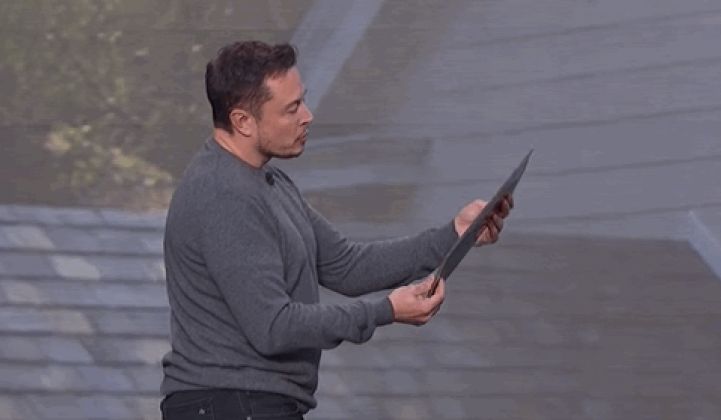An insider account of the development of Tesla and SolarCity's much-hyped solar roof reveals new details about how the product came together.
The project, code named "Steel Pulse," was originally a standing-seam metal roof developed by a team at Zep Solar within SolarCity's R&D unit, overseen by Zep's Jack West and SolarCity Chief Technology Officer Peter Rive. It was not originally made out of tempered glass solar shingles.
When Elon Musk first saw the product, he reportedly called it a "piece of shit" because of its aesthetic. But he loved the idea.
Austin Carr, a technology reporter for Fast Company, has been reporting for months on the Tesla acquisition of SolarCity. His full feature article, released this week, is filled with insider details about the melding of the two companies. It's worth your time. (Before the article came out, one high-level Tesla source told me that the article would be "quite the doozy" for what it revealed.)
Among many other revelations, one source told Carr: "There was almost no understanding for what SolarCity was inside the broader company, and that includes Elon. They didn’t understand the business."
Musk, who thought the installation process was "incredibly clunky and awkward," immediately prioritized development of a new product that "had to knock your fucking socks off."
This morning, Fast Company published a supplement to Carr's series that looks specifically at how the Solar Roof came together. Developing the product was a last-minute scramble, caused by Musk's dislike for the first iteration and the desire to make a big splash for investors. Carr writes:
In late 2015, [Jack] West and the Zep Solar team, which functioned as one of SolarCity’s R&D units, started more seriously exploring whether they could build an “integrated roof,” meaning that the solar cells would be built inside the roof itself. Such a vision would require that SolarCity begin handling complete re-roofing jobs, rather than simply installing solar panels. When West and team brought the idea to SolarCity execs, they stressed the advantages that SolarCity, with all its resources, would have going head-to-head with traditional construction companies and independent roofers, boasting in meetings that they would “kick their asses.”
Musk and Peter Rive were eventually sold on the idea, and SolarCity set about exploring a number of potential implementations. Though Peter and West considered a tiled concept early on too, they prioritized the development of a standing-seam metal solar roof -- that is, Steel Pulse -- and put together test concepts in San Rafael in the spring and early summer of 2016. “It was like a monolith, this ugly metal roof,” says someone familiar with Steel Pulse. A former SolarCity executive adds that some employees even “loathed” it. But there were cogent reasons to move ahead: It was inexpensive and brought efficiency advantages in terms of estimated solar conversion and installation times.
Musk, who had seen early concepts, apparently wasn’t as disdainful of the aesthetics at the time, because he hopped on that August 9 SolarCity earnings call to talk up its potential. Only weeks later, when he saw it on the customer’s roof, did he tell Peter Rive and Jack West that the Steel Pulse prototype was “a piece of shit” and push the team toward developing a better-looking version. (A spokesperson for Tesla clarifies that Musk “very much liked the idea of Steel Pulse. He simply did not like the first iteration.”) “He would say, this has to be insanely beautiful -- that it had to knock your fucking socks off,” says a source.
There is still a bit of mystery over when execution ramped up. The Zep team spearheaded the project under SolarCity. But executives within Tesla and SolarCity were cagey over the exact motivations for accelerating the product -- apparently concerned it would look as if they used the solar roof to sell investors on their merger. (During the investor vote, Musk spent the entire time talking about the roof.)
Some sources interviewed for the story were cynical about the timing. Another revelation from the piece: the solar roofs hooked up at last fall's demo weren't actually functional.
But in this particular instance, considering the timeline of Steel Pulse’s development with the SolarCity acquisition, some insiders have wondered if Musk sold shareholders on a product that didn’t exist. “It’s all about the narrative for Elon,” says a source close to Musk. “Solar Roof was as ‘real’ as anything he’s ever shown [off to the public]. Was it a finished product? By no means.”
(As one jokes, “There’s a reason that they announced the idea on a fake block in a fake neighborhood with fake houses!”) A well-connected source explains, “Basically, from August to October, it was more about getting the thing to look right, and then from October until now, it’s really about getting the thing to work. This is just how Tesla does things. Their first car demo [for the Model S] was held together by magnets.”
Tesla finally released more details about the solar roof last month. The estimated price came in lower than expected, but is still much higher than standalone PV. The company will only offer very limited customized products in California starting in the summer. For now, Tesla's solar roof calculation tool is a creative way to compile leads as its solar division walks away from door-to-door sales.
Read Austin Carr's full piece.
Below, listen to our Energy Gang podcast detailing the economics and application of Tesla's solar roof.



